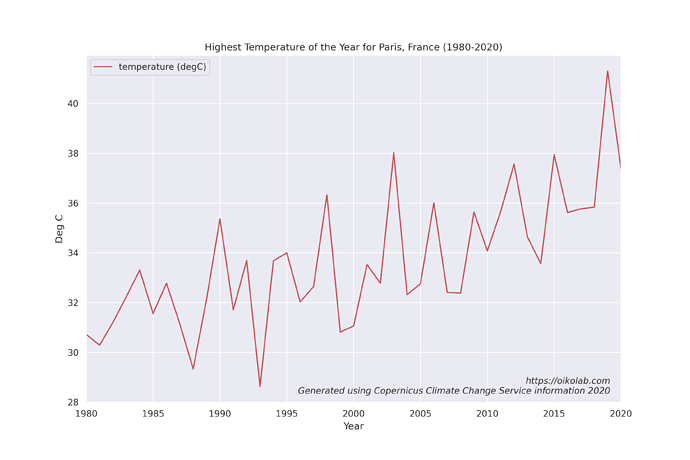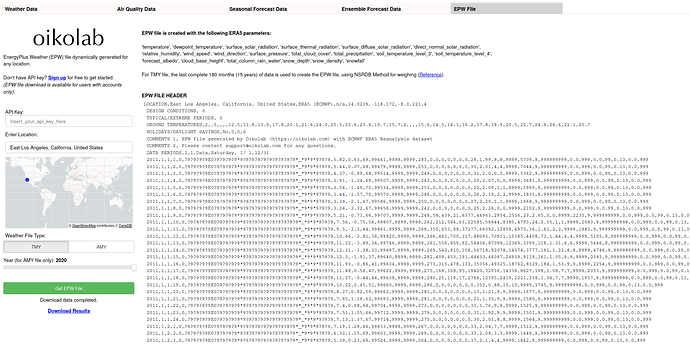Please, Can I get a epw file to Sana’a Yemen. Thanks to all.
Hi All,
For a location for which a weather file is not available from any source, and paying for proprietary services is not an option, is there a way to fabricate weather data?
Chris,
Can Dragonfly help in this regard?
What I have come up with in my search on this is Urban Weather Generator from MIT that generate hourly urban air temperature and humidity values for a location based on weather data for that city. But what I am interested in is rather a full fabricated weather file.
Thanks,
-Devang
Hi Devang,
I may be saying a huge stupidity, but if there is no other option… may it be worthy to take like 4 epws of the closest places that you can find and create your own file using the interpolation algorithms that meteonorm uses for the same problem? It will never be exact but… don’t know, better than nothing
Having a quick look I didn’t find the exact algorithms, but these 2 articles may help you
https://www.researchgate.net/profile/Jan_Remund/publication/2414913…
Greetings,
I’ve been looking for an epw file for the city of Santa Cruz de la Sierra - (biggest city in Bolivia but not capital), and there isn’t any. Nearby cities have really different situations, so is it possible to edit one nearby as template and create the one for Santa Cruz de la Sierra?
Best regards,
This is very useful! @mostapha!I have tried to download the epw from these websites,but I find I can only get the data of the lastest year.If I want to get the epw files over a series of years,how I can get them.
Not sure if this has been discussed before but if you go onto PVGIS ( http://re.jrc.ec.europa.eu/pvg_tools/en/tools.html ), you can get synthetic weather data in .epw formats for any location. It will be under TMY (Typical meteorological Year) on the left panel.
Not sure about the credibility of the source, but it’s the same with most synthetic .epw files I guess.
Cheers
The source is very credible - the work is very similar to NREL, but by European Commission.
This is amazing! Can you provide any background information on how accurate the data is and the different types of data (wind, temperature, radiation, etc.)? This sounds very promissing!
You can find some validation data here - https://ec.europa.eu/jrc/en/PVGIS/docs/methods. Per my post here I use weather reanalysis data from European data source (ECMWF) quite extensively for my service. Free free to try it with the script that Chris wrote if you’re looking for AMY EPW data.
Thanks Joseph, I still don’t quite understand how the different data is interpolated (wind, radiation, etc.).
I recently tried getting weather data for Monaco in europe but couldn’t find anything. We went for a file from the city Nice, which is 10km away but were told that the wind direction from Nice doesn’t match what the client suggested it would be in Monaco. We then downloaded an epw from PVGIS and it represented the local climate as the client described it.
How is that possible?
As discussed here (https://ec.europa.eu/jrc/en/PVGIS/tools/tmy), PVGIS is generated from a combination of satellite-based solar radiation database and ERA-Interim reanalysis dataset (https://www.ecmwf.int/en/forecasts/datasets/reanalysis-datasets/era-interim). Climate re-analysis is a process of assimilating observation data into a physics-based atmospheric model, a bit like Kalman filter (https://en.wikipedia.org/wiki/Kalman_filter) so you’d get more consistent state estimation of atmosphere across many different parameters, even ones that are not measured - here’s a good 3-min video on the topic.
Also, if you’re using the TMY file from Nice, note that this particular TMY is pieced together from 1982 - 1997 records by month by ASHRAE. I can’t say why the wind direction might be different but the methodology of piecing together month by month is obviously not going to be perfect and climate change is already affecting many places so do take any TMY data with a grain of salt.
For instance, you can see below how the highest temperature in Paris has gone up by 10 degC over the last several decades. In the TMY file for Paris, the maximum temperature is still only 30 degC.
This post is extremely helpful. I am conducting a heat mitigation study for a residential neighborhood which is in an urban heat island in East Los Angeles. I therefore require a UHI weather data file to represent conditions much hotter than what’s found in the energyplus TMYs.
Could anyone suggest where I can get a weather data representative of a particular UHI location?
If someone already has a file and can share it, that would be great as well.
Thank you,
Kay
Feel free to try weatherdownloader.oikolab.com for updated TMY or AMY data generated from ERA5 dataset. This was updated just a few weeks ago to include TMY file so any feedback would be appreciated.
@Kay ,
If you’re trying to model urban heat island scenarios for a specific district, another option would be to morph the rural or airport EPW to account for urban heat effect using the Urban Weather Generator (UWG), which @josephyang improved as part of his thesis a few years ago. The uwg_sample.gh file that’s included in the Food4Rhino download shows how to set up a Dragonfly model for input into the UWG.
FYI, here’s the change in climate for East Los Angeles. If you use TMY from EnergyPlus site, you’re using data from mostly 70s and 80s - it’s great if it works for your project but I wouldn’t really recommend it. Suggest at least keeping up with period that correspond to the latest NOAA climate norm (1991-2020).

Hi @mostapha ,
I have checked on epwmap (ladybug.tools) website for looking Ruteng, Indonesia and Luwu Utara, Indonesa epw file, I found on the website but seems missing the data “The requested URL was not found on this server.”.
Could you help me to get the data?
Thanks
@p0p1p0, Some of the links in epwmap are not working mainly because they refer to wrong file name, wrong years, etc. But if you go to onebuilidng site itself, you can find the link that works. For Indonesia, here is the link:
https://climate.onebuilding.org/WMO_Region_5_Southwest_Pacific/IDN_Indonesia/index.html
Best,
Farhang
Has anyone tried morphing epw data to RCP scenarios in LBT, or maybe has tips on how to approach this?
I reckon it is not the easiest thing to do, but then again I am not in the search for the most accurate workflow.
Thanks!
Hey @erida.bendo, I’ve use this in the past - I think it has some limitations on what scenarios are available but it’s been a while since I used it.

